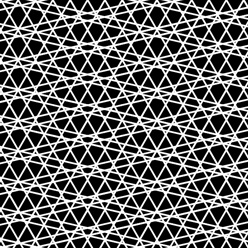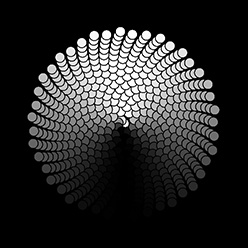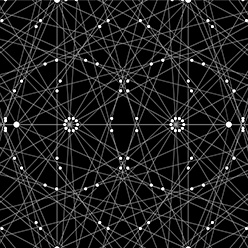Line pattern
This is a pattern which is created by 2 individual lines that reflect on the edges of the canvas. Each new run will result in a new pattern.
Ropes
A flow field drawing ropes in a retro comic style with singular ellipses that connect together to one rope. Play with the parameters to get very different results.
Meteroids
Multiple three dimensional spheres with displacement rotating around the center making it look like in orbit. Use your mouse to interact with the rotation.\
Mountains
Mountains with triangular shading and a path in front of the Aurora Borealis.
Phylliotaxis
A formula which is common in nature and creates a spiral shaped flower head.
Neural Network
Visualising networks and connectivity in an abstract way. This generative artwork creates lines shaping a network and sends little dots (representing the data) through it.
Line
A basic element in art, used to create boundaries or connections.
Polygon
Building blocks to form complex shapes and structures.
Shape
Fundamental component used to construct and manipulate visual forms.
Spiral
A dynamic pattern often utilized to create movement and flow.
Color
Essential in generating visual interest.
Scale
Manipulate the size of objects, influencing perception and composition.
Stroke
Adding detail by controlling the thickness and style of lines.
Fill
Coloring the inside of shapes, adding depth and complexity.
Rotation
Changing the orientation of the objects for visual effects.
Concentric
Used for generating patterns that radiate from a common center.
Radial
Alignment creating rays extending from a central point.
Grid
Organize and align elements in compositions.
Parallel
Lines or objects side by side having the same continous distance between them.
Offset
Shifting elements to create depth or unconventional alignments.
Pattern
Creating rhythmic repetition and visual coherence.
Angled
Incorporation of angles to infuse energy or influence direction.
Repetition
Repeating elements to establish visual consistency.
Subdivision
Dividing shapes into smaller chunks to create detailed patterns.
Spacing
Distance between elements to balance density and openness.
Symmetry
Mirroring elements for visual balance.
Loop
A seamless animation where start and end are matching.
Warp
An effect creating distortion and movement.
Recursion
Repeatedly applying a set of rules.
Random
The most important for unpredictability and unique designs.
Perspective
Utilising depth and dimension for two or three dimensionality.
Animation
Adding movement can create liveliness.
Texture
Incorporating elements as noise to enhance the visual richness.
Time
Integrating time as a dynamic element to evolve visuals.
Framerate
Controlling the speed of animations.
Hover / Touch
Visual changes or responses in the artwork through hover.
Mouse Position
Utilizing cursor location to influence real-time changes in the visual.
Click & Press
Transformations or transitions through the press or click.
Zoom-In / Out
Explore details by controlling the view's magnification.
Key Press
Using keyboard input to influence the artwork.
Noise
Utilizes random fluctuations to introduce complexity and organic textures in generated patterns.
Flowfield
A vector field that guides moving particles to create fluid-like patterns and behaviors.
Harmonographs
Mathematical devices that combine oscillations to create intricate drawings.
Cell Automation
A method that employs algorithmic rules to simulate cells evolving over time.
Voronoi
A diagram used to partition space into regions, influencing the layout and design.
Fractals
Structures that repeat at every scale to create complex, self-similar patterns.
Packing
The algorithmic arrangement of shapes without overlap, forming dense compositions.
Predator & Prey
A simulation system modeling the interactions between predators and prey, influencing emergent patterns.
Strange Attractor
Mathematical constructs that define chaotic systems, used to generate unpredictable and intricate paths.
Phyllotaxis
The arrangement of leaves in plants generating inspiring geometric patterns.
L-System
Algorithmic rules used to model organic growth and procedural development of plants or fractals.
Gravitational System
Simulating gravitational forces between objects, influencing their movement and interactions.
Neural Network
The visualization method of artificial networks.
Maze
Create complex networks of paths.





